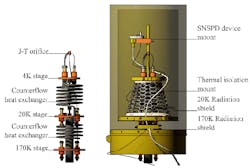Compact cooling technology advances SNSPD single-photon detectors
A new form of compact cooling technology developed for space astronomy could pave the way for use of advanced superconducting detectors for better cancer treatments, driverless cars and practical quantum communications. In a Letter published in the journal Superconductor Science and Technology, researchers from the University of Glasgow and the STFC Rutherford Appleton Laboratory describe how they have developed a supercooled detector platform capable of detecting single photons with low-enough power consumption to be used outside of a laboratory environment for the first time.
RELATED ARTICLE: SNSPD-based system to enable free-space mid-IR communications
Their research builds on existing developments in extremely sensitive light sensors known as superconducting nanowire single photon detectors (SNSPDs). These SNSPDs are capable of detecting individual photons--even at infrared wavelengths. While SNSPDs have facilitated numerous significant advances in quantum science over the last decade, they need to be cooled to a just few degrees above absolute zero (-273.15 °C) in order to work effectively--a process which requires expensive and hazardous liquid helium, or a great deal of electrical power to achieve.
The research team has developed a more portable, less power-hungry platform for SNSPDs that opens up a wide range of new applications for the technology. Nathan Gemmell, of the University of Glasgow's School of Engineering, is the lead author of the Letter and says, "We've adapted technology initially developed for the European Space Agency's Planck mission, which launched in 2009 and successfully surveyed cosmic background radiation in the microwave and infrared frequencies of the spectrum over four and a half years in space. We've taken a fibre-optic coupled superconducting detector supplied by the Dutch start-up Single Quantum BV and housed it in a miniaturised cooler capable of reaching temperatures of 4.2 Kelvin, or -268.95 °C, which runs from standard mains power."
The research outlines how the team is able to use the SNSPD for infrared single-photon light detection and ranging (lidar), a form of distance measurement that could play a key role in the development of systems suitable for driverless cars in the future. They have also been able to detect infrared photons at a wavelength of 1270 nm, the signature of a form of excited oxygen known as ‘singlet oxygen’ that plays a key role in many biological and physiological processes. In photodynamic therapy (PDT) cancer treatment, the treatment drug exchanges energy with surrounding oxygen molecules on optical excitation, creating singlet oxygen radicals that kill tumor cells. The miniaturized cooling platform makes SNSPD use in clinical PDT much more practical, potentially making cancer treatments more effective.
Cathy Foley of CSIRO and editor-in-chief of Superconductor Science and Technology said, "This is a very exciting report and a genuine breakthrough. This work shows that advances in cryogenic engineering will enable superconducting quantum technologies to have decisive impact in a host of real-world applications."
SOURCE: University of Glasgow; https://www.gla.ac.uk/news/headline_551407_en.html

Gail Overton | Senior Editor (2004-2020)
Gail has more than 30 years of engineering, marketing, product management, and editorial experience in the photonics and optical communications industry. Before joining the staff at Laser Focus World in 2004, she held many product management and product marketing roles in the fiber-optics industry, most notably at Hughes (El Segundo, CA), GTE Labs (Waltham, MA), Corning (Corning, NY), Photon Kinetics (Beaverton, OR), and Newport Corporation (Irvine, CA). During her marketing career, Gail published articles in WDM Solutions and Sensors magazine and traveled internationally to conduct product and sales training. Gail received her BS degree in physics, with an emphasis in optics, from San Diego State University in San Diego, CA in May 1986.
